
The CN Tower is a 553.3 m-high (1,815.3 ft) communications and observation tower in Toronto, Ontario, Canada. Completed in 1976, it is located in downtown Toronto, built on the former Railway Lands. Its name "CN" referred to Canadian National, the railway company that built the tower. Following the railway's decision to divest non-core freight railway assets prior to the company's privatization in 1995, it transferred the tower to the Canada Lands Company, a federal Crown corporation responsible for the government's real estate portfolio.
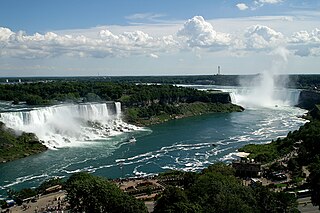
Niagara Falls is a group of three waterfalls at the southern end of Niagara Gorge, spanning the border between the province of Ontario in Canada and the state of New York in the United States. The largest of the three is Horseshoe Falls, which straddles the international border of the two countries. It is also known as the Canadian Falls. The smaller American Falls and Bridal Veil Falls lie within the United States. Bridal Veil Falls is separated from Horseshoe Falls by Goat Island and from American Falls by Luna Island, with both islands situated in New York.
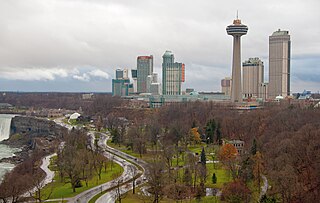
Niagara Falls is a city in Ontario, Canada, adjacent to, and named after, Niagara Falls. As of the 2021 census, the city had a population of 94,415. The city is located on the Niagara Peninsula along the western bank of the Niagara River, which forms part of the Canada–United States border, with the other side being the twin city of Niagara Falls, New York. Niagara Falls is within the Regional Municipality of Niagara and a part of the St. Catharines - Niagara Census Metropolitan Area (CMA).
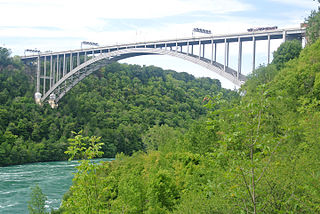
The Lewiston–Queenston Bridge, also known as the Queenston–Lewiston Bridge, is an arch bridge that crosses the Niagara River gorge just south of the Niagara Escarpment. The bridge was officially opened on November 1, 1962. It is an international bridge between the United States and Canada. It connects Interstate 190 in the town of Lewiston, New York to Highway 405 in the community of Queenston, Ontario. The Lewiston–Queenston Bridge is architecturally similar to the Rainbow Bridge at nearby Niagara Falls.
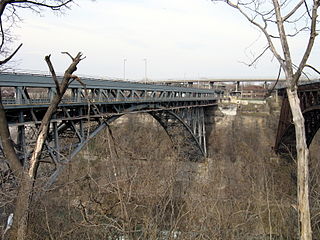
The Whirlpool Rapids Bridge, commonly known as the Whirlpool Bridge or the Lower Steel Arch Bridge, is a spandrel braced, riveted, two-hinged arch bridge that crosses the Canada–United States border, connecting the commercial downtown districts of Niagara Falls, Ontario, and Niagara Falls, New York. This bridge is located approximately 1.5 kilometres (0.9 mi) north of the Rainbow Bridge and about 2 kilometres (1.2 mi) from the Falls. It was acquired by the Niagara Falls Bridge Commission in January 1959. Immediately upstream is the similar arch-style Michigan Central Railway Bridge, which has been out of service since 2001.

Casino Niagara is a commercial casino located in Niagara Falls, Ontario, Canada. It opened on December 9, 1996, on the site of the former Maple Leaf Village amusement park. With a prime location beside Clifton Hill, it was originally conceived as a temporary facility until Niagara Fallsview Casino Resort opened but has remained open as a permanent facility. It is the second casino to open in Ontario and the first to feature electronic roulette. Casino Niagara has over 1,300 slots and over 40 table games, as well as sports betting. Apart from the pandemic, the casino has operated for 25 years.

The Skylon Tower, in Niagara Falls, Ontario, is an observation tower that overlooks both the American Falls, New York, and the larger Horseshoe Falls, Ontario, from the Canadian side of the Niagara River.

An observation deck, observation platform, or viewing platform is an elevated sightseeing platform usually situated upon a tall architectural structure, such as a skyscraper or observation tower. Observation decks are sometimes enclosed from weather, and a few may include coin-operated telescopes for viewing distant features.
Maple Leaf Village is a former amusement park and entertainment complex in Niagara Falls, Ontario. Opened in May 1979 it was operated by Conklin Shows. Falling on hard economic times in the early 1990s, it was restructured and replaced with Casino Niagara, a government-run casino.

The Tower Hotel, opened in 1962, is located in the Fallsview district of Niagara Falls, Ontario and was the first of the contemporary observation towers built near the brink of the Falls. It features an indoor observation deck, restaurant, and hotel. The tower is 99 metres tall above street level and 160 metres above the falls. The tower assumed its present name in 2010 as a result of its most recent renovation; as Minolta was the longest-tenured sponsor of the building, tourists and locals may still call it the Minolta Tower.
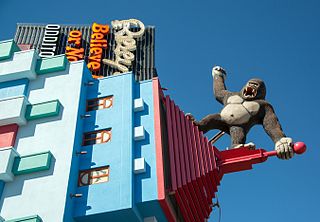
Clifton Hill is one of the major tourist promenades in Niagara Falls, Ontario. The street, close to Niagara Falls and the Niagara River, leads from River Road on the Niagara Parkway to intersect with Victoria Avenue, and contains a number of gift shops, wax museums, haunted houses, video arcades, restaurants, hotels and themed attractions. It is a major amusement area and centre for night life, particularly for families and teenagers.

The Niagara Falls Suspension Bridge stood from 1855 to 1897 across the Niagara River and was the world's first working railway suspension bridge. It spanned 825 feet (251 m) and stood 2.5 miles (4.0 km) downstream of Niagara Falls, where it connected Niagara Falls, Ontario to Niagara Falls, New York. Trains used the upper of its two decks, while pedestrians and carriages used the lower. The bridge was the idea of Canadian politicians, and it was built by an American company and a Canadian company. It was most commonly called the Suspension Bridge, although other names included Niagara Railway Suspension Bridge, Niagara Suspension Bridge, and its official American name of the International Suspension Bridge.

The Prospect Point Observation Tower is a tower in Niagara Falls, New York, United States just east of the American Falls.
The Niagara Parks Commission, commonly shortened to Niagara Parks, is an agency of the Government of Ontario which maintains the Ontario shoreline of the Niagara River.

Journey Behind the Falls is an attraction in Niagara Falls, Ontario, Canada located in the Table Rock Centre beside the Canadian Horseshoe Falls. It is open year round and run by the Niagara Parks Commission.

The Michigan Central Railway Bridge is an out-of-service steel Deck arch bridge spanning the Niagara Gorge between Niagara Falls, Ontario and Niagara Falls, New York. The bridge is owned by Canadian Pacific Kansas City, which purchased the single track structure in 1990. The Canadian corridor and bridge are owned by the City of Niagara Falls, Ontario. The bridge is located just upstream from the older arch-style Whirlpool Rapids Bridge used by Maple Leaf Amtrak passenger trains.

There have been several different incline railways built at the Niagara Falls, on the border between Canada and the United States.

The Niagara Falls Station and Customhouse Interpretive Center is an intermodal transit complex in Niagara Falls, New York. It serves Amtrak trains and Niagara Frontier Transportation Authority buses, houses U.S. Customs and Border Protection offices servicing the Canada–United States border, and houses the Niagara Falls Underground Railroad Heritage Center.

Terrapin Point is an observation area located in Niagara Falls, New York at the western tip of Goat Island, next to the Canadian Horseshoe Falls. It is one of two major observation areas to overlook the falls and lower Niagara Gorge on the New York side, the other being Prospect Point further downriver.

The Sheraton Fallsview is a 22-story hotel located within Falls Avenue Resort in Niagara Falls, Ontario, Canada.




















